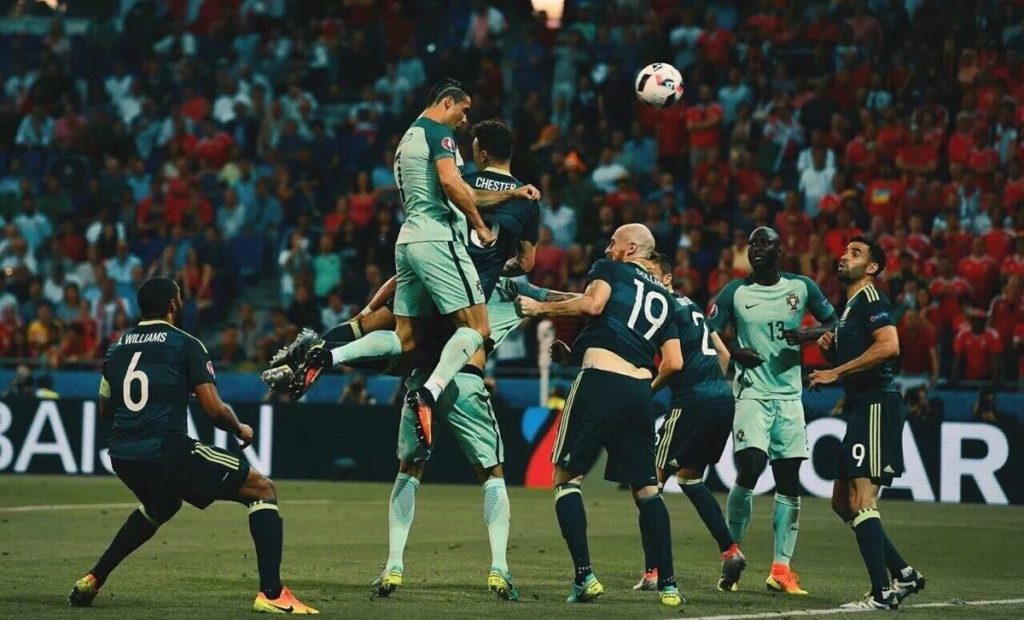The first project I officially worked on inside football didn't involve statistics, but it did involve analysis. My task was to take all the video for teams we knew were unusually good at set pieces, analyse what they were doing, and build a guide of best practices. Needless to say, we had some success.
What follows is a translation of two presentations I typically give to teams about this topic. I believe my work here remains fairly unique in the football world, and it has certainly benefited from working with top coaches like Gianni Vio and Brian Priske.
I can also assure you that when it comes to set pieces, we are just barely scratching the surface of what is possible.
The Why Of Set Pieces
The traditional view of set pieces seems to go something like this.
These two guys

use set pieces to help their thuggish, under-technical teams avoid relegation. Take some big, strapping lads. Toss a bunch of them in the box. Throw it into the mixer, and voila! It's a valid, proven strategy that they have executed time and again.
But what if a talented team started to take set pieces seriously?
Then a team lead by this guy

could beat out these two guys

to a league title, despite a huge gap in wages and transfer spending.
Funnily enough, something like this happened in England as well.
Sir Alex Ferguson clearly started paying more attention to Manchester United's set piece execution his last two seasons in charge, to the point that their data looks more like Stoke then and less like historic Fergie. Patrice Evra started scoring off headers for the first time in his career, and Wayne Rooney and Robin van Persie - two clear strikers - were relocated outside of the box to provide the best delivery possible on corners.
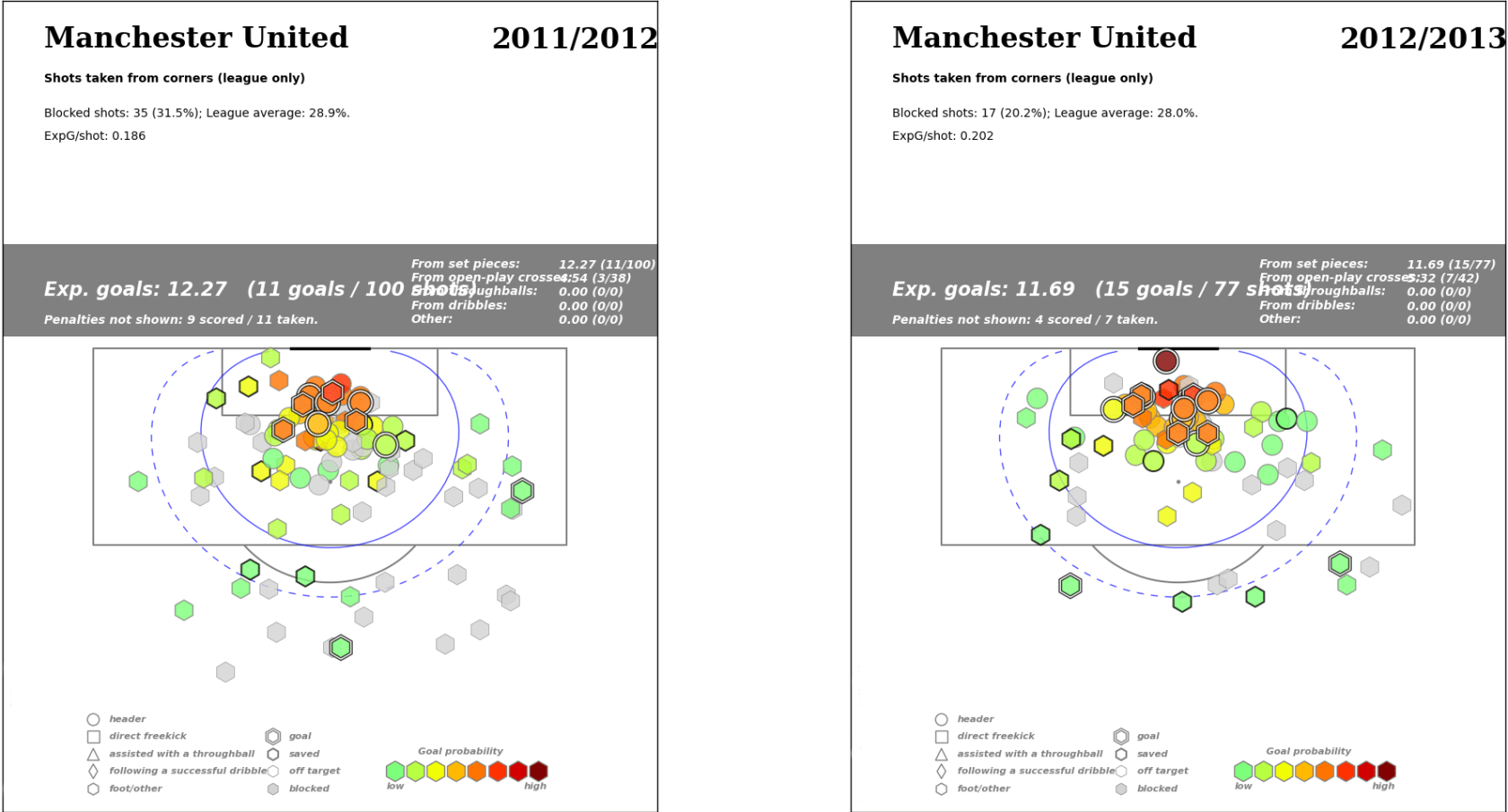
It's not the only reason United performed well in those final Fergie seasons despite an aging squad and very little transfer spending, but it certainly helped move the needle.
And finally, an emphasis on better set piece execution can help even small budget teams win titles.

I hate to talk about this next part publicly, but now is the time.
It's not just corners where teams can gain a significant edge in execution. It's also free kicks and...throw-ins
Most clubs get nothing from throw-ins. As a matter of fact, for most teams a throw-in is worse than a normal possession in terms of goal expectation. It doesn't have to be that way.
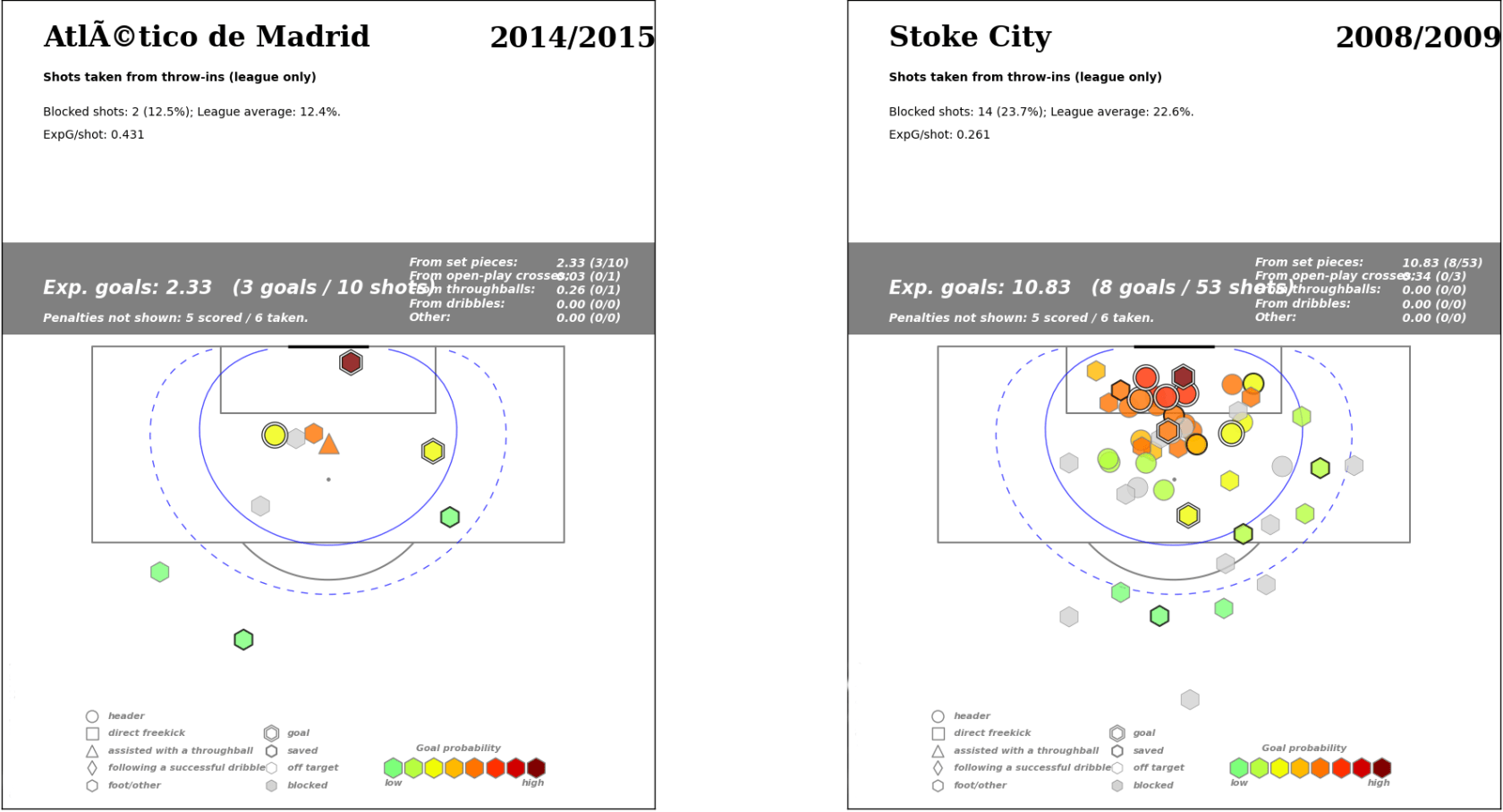
Atletico Madrid toyed around with long throws back in 14-15 and created three goals from them. As you can see from the video above, FC Midtjylland obviously started creating goals from throw-ins themselves. Meanwhile, trailblazing tactical pioneer Tony Pulis and Stoke in 08-09 created 53 shots and eight goals off long throws alone. This is a phase of play where the vast majority of teams produce nothing. Stoke produced a shot and a half a game (which was like 15% of their total shots) just from throw-ins during the Rory Delap years.
If you are able to build and execute a long-throw program, it's the equivalent of magicing free goals out of thin air.
But what does it cost you?
Well first of all, it costs coaching expertise. There are very few coaches or analysts in the world who are capable of building a set piece program from scratch and executing it at a high level.
It also takes hard work. Players need to know that this phase of the game is important to the team, and they need to concentrate on executing it correctly, every time.
I have a video I like to show of the guy who finished third in the Ballon d'Or voting this year busting his ass to learn better set piece technique. Think you are too good to work hard at perfecting this area of your game? Antoine Griezmann says you're wrong.
Finally, it takes training time.
Now this may sound like a weird point of emphasis, but I cannot tell you how many clubs I have walked into and asked this simple question:
How much time do you spend training set pieces?
The answer is usually between five and fifteen minutes.
A week.
Now set piece goals typically account for between 25% and 33% of all goals scored in the course of a season. It would be more correct - but still under representing the percentages - to spend fifteen minutes a day on set pieces. Yet most teams barely pay attention to this phase of the game.
Most clubs average around .3 goals a game off set pieces.
Elite clubs can push this number up to .75 or .80 goals from set pieces alone. That's not an exaggeration - the keys are in the data.
What is the value of adding 15-20 goals a season to your club without having to pay the transfer fee or wages of a 15-20 goal a season striker, which in the modern day is likely to cost 100M all-in?
How can clubs afford not to concentrate on this area of production?
But I see you, you are skeptical.
It is totally natural to disbelieve when someone claims they can do magic, even if they perform the trick right in front of your eyes.
How about some practical application then?
Designing and Executing Set Pieces from Scratch
We talkin' 'bout practice...
This stuff operates from a single fundamental principle.
Goals from set pieces are not luck.
- Through studying historic successful teams, I created a program that dramatically improved set piece performance and execution.
- The principles the program is based on are simple, but like anything in football, it takes time to teach players and coaches how to execute at a high level.
- Many times people in football will claim something is obvious once you have pointed it out to them. However, the number of clubs not doing these supposedly obvious things is staggering. Knowing the edges are there in the first place is massive and unusual.
What follows is a real world workflow of analysing the problem, creating the solution, training the solution, and then executing it on the pitch for .
Step 1: Identify the defensive scheme.
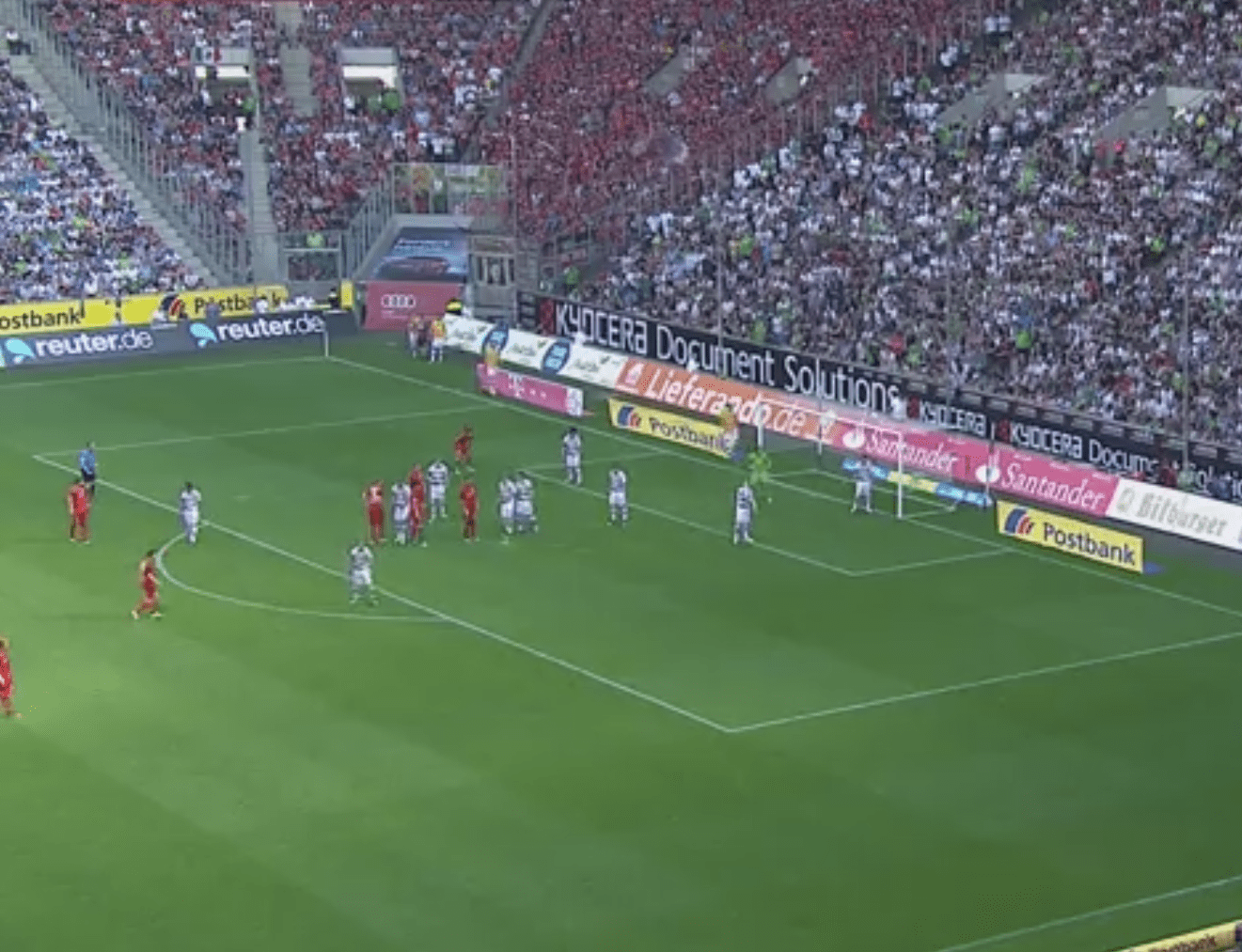
Here you see the defensive corner setup for the next opponent. Their structure is a 3-man near post zone plus hybrid man marking.
Step 2: Figure out how to break the scheme.
Looking at the defensive scheme above, I thought a bit about how we might cause them some problems. There are a number of different things you could do, but my first thought was what would happen if we place a man in the box like he was screening the GK, but have him run out of the box to the corner flag as if he were taking a short corner?
Something like this:
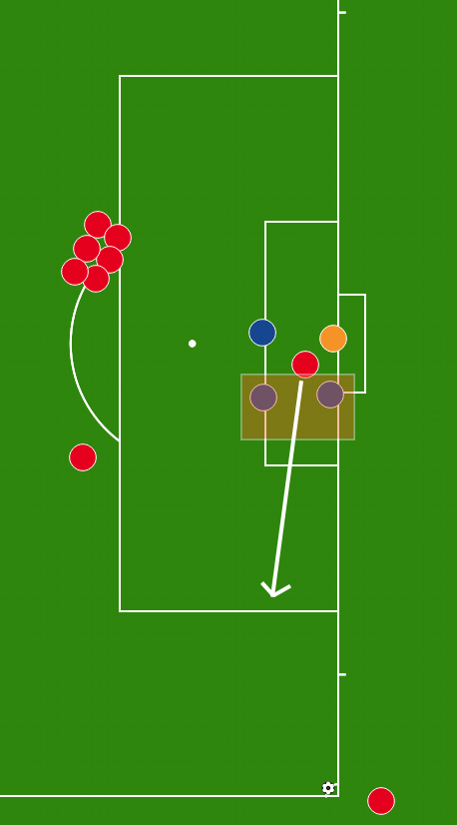
My guess was that at least one of the zonal markers would come with our player, thus weakening the zone in a crucial area. Alternatively, if none of the markers follow our player, we now have a 2 vs 0 in a wide area with a good dribbler on the ball to create havoc.
There are a lot of other coaching points involved here for the players, and explanations of why the setup looks this way, but the basics are all here. I will also note that this is literally week 1 for the team, so keeping things simple is absolutely crucial.
Once we have the play designed, we then produce route assignments for the players to memorize. This behaviour becomes completely natural over time.
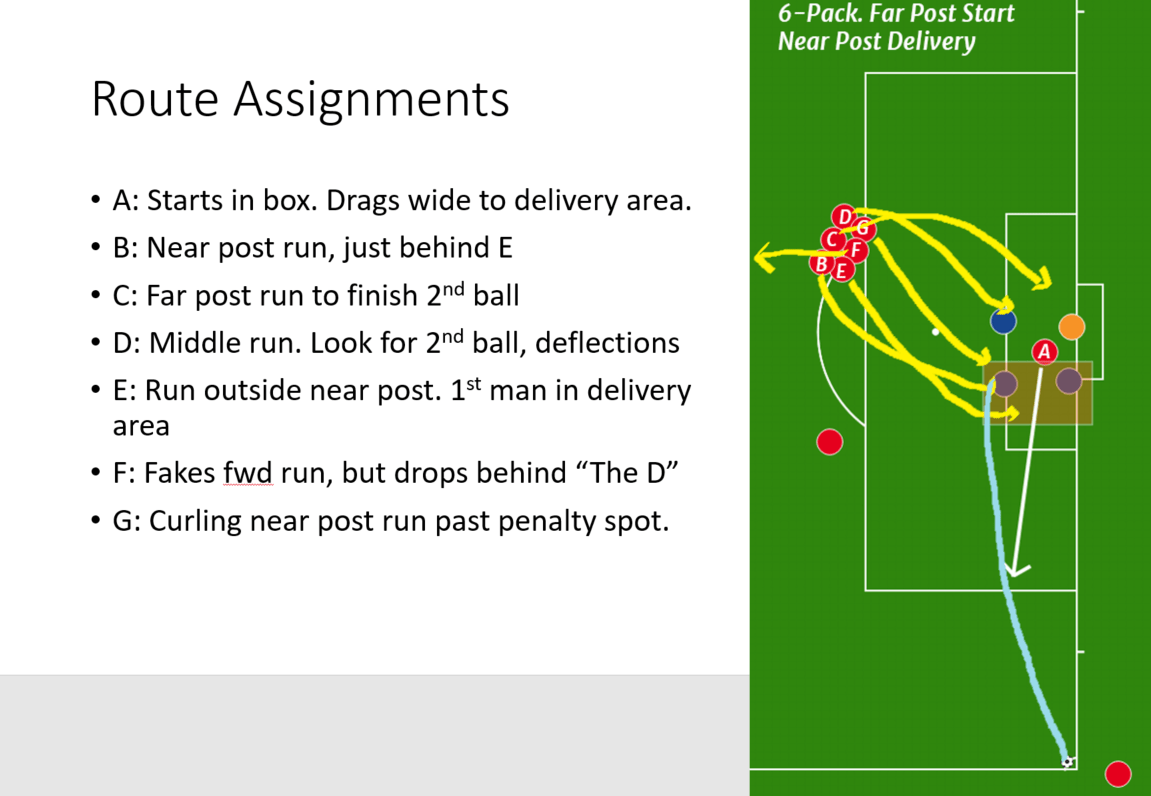
You can tell this is real because it was the first time I had produced these on the fly and they are really ugly due to time crunch. Modern versions are a bit cleaner and more attractive.
You then also have the animation for the play, produced here in GloballCoach.
Step 3: Train the play.
There are some minor orientation elements I would correct here, but overall it's not bad for a first try.
Step 4: Execute in the game.
A few notes on the video below before you watch it.
- Pay attention to the player near the GK and what happens when he moves.
- Pay attention to what happens to the zonal defense around the box.
Conclusion
I don't think I am overstating it when I say set piece execution is one of the most misunderstood, undervalued, and underexploited edges in the game of football.
A single goal in the Premier League right now is worth approximately £2.5M. The ability to conjure these extra goals out of nothing but time and hard work has enormous value, but almost no teams in world football are executing set pieces at a consistently high level.
What I showed above only scratches the surface of the potential expertise in this area can have on results, in almost any league. Add in route concepts, long throw programs, packaged plays, and skilled delivery players and it's possible teams could create over a goal a game from set pieces alone. The possibilities for someone with a clever imagination are limitless, which also means you become extremely painful to mark because the opposition never know what your players are going to do.
Obviously the inverse is true as well. Skilled practitioners can also design better defensive schemes on a game by game basis (if necessary) to stop other teams from scoring against you.
I don't talk about the details much in public because I generally subscribe to the belief of never talking about your edges to the outside world. The media campaign FCM did about their set piece success during the title season was painful and I am certain it cost them easy goals in subsequent years. On the other hand, now that I don't work there, I'm happy they did, because it means you all know about the details.

